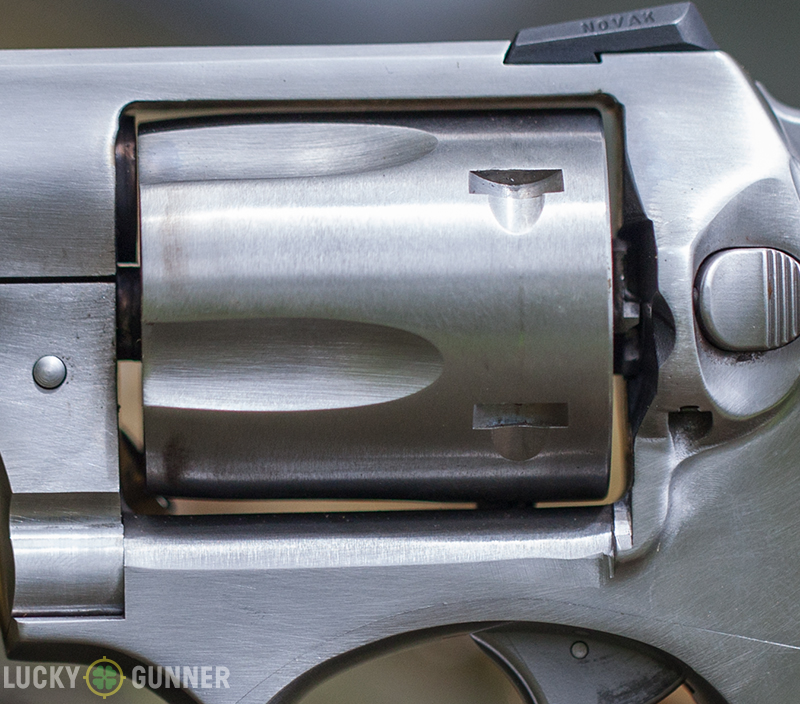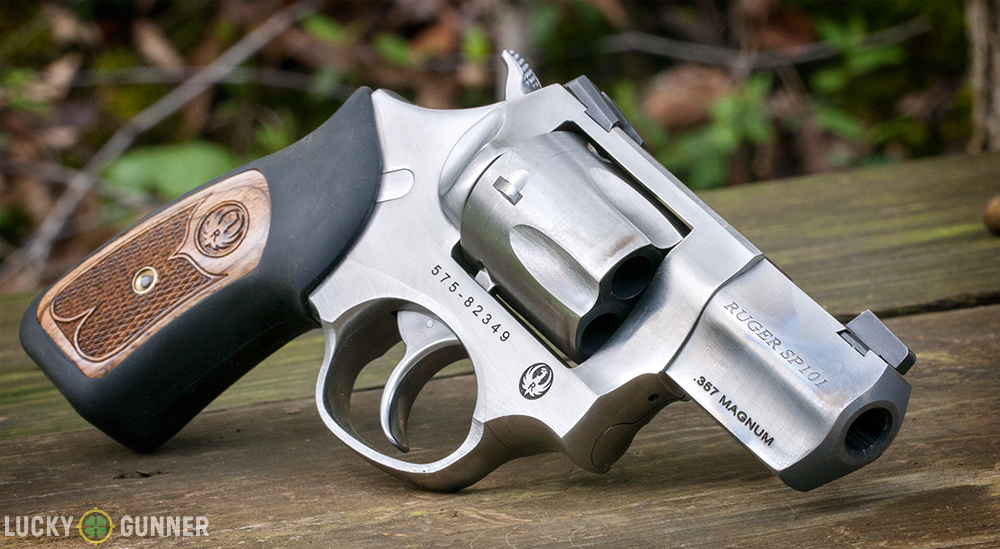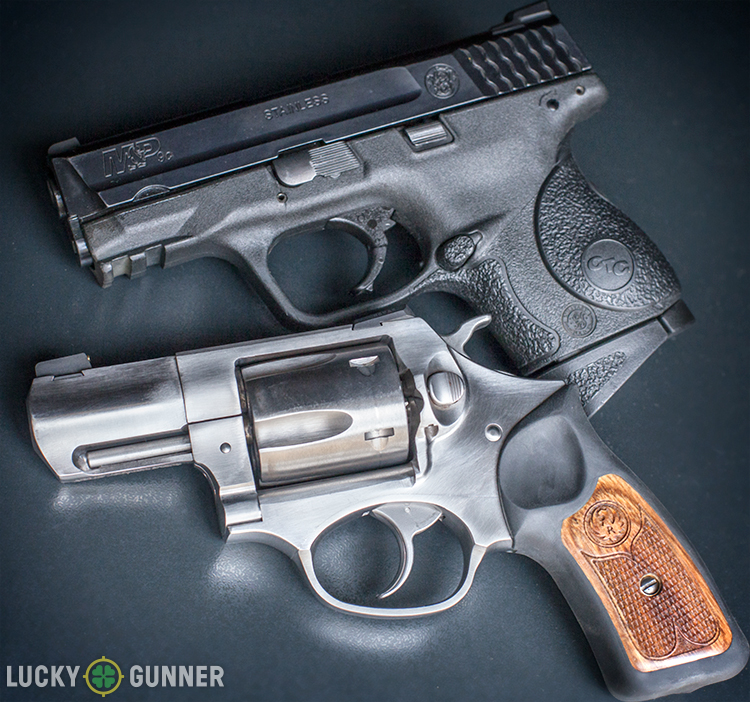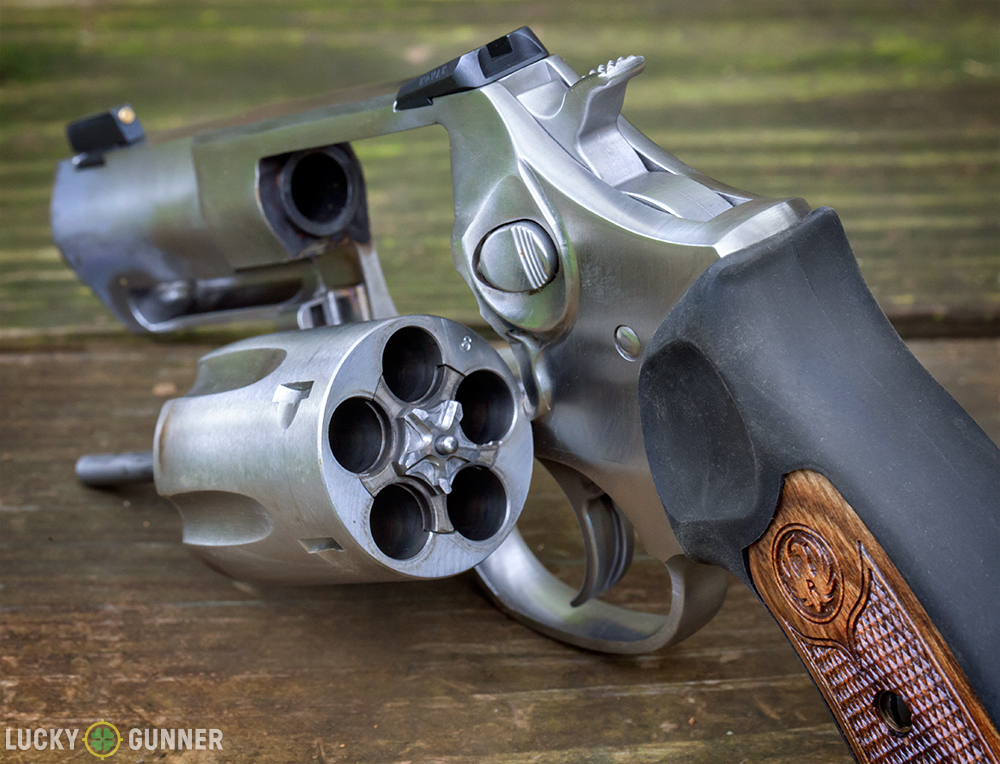Welcome to another Wheel Gun Wednesday! We’re picking back up where we left off a few weeks ago with my quest for the ideal carry revolver. In case you’re just joining us, I started off by laying out some criteria for what I consider to be the features to look for in a revolver that’s as easy to shoot and train with as it is to carry every day. The first candidate I profiled was the S&W 386 followed by a pair of 3-inch K-frames. Testing with those guns is ongoing, and today I’m adding the next contender: Ruger’s SP101.
Primary vs. Secondary
In most parts of the U.S., the practice of carrying a concealed handgun has only become common and legal within the last few decades, but the popularity of small frame snub nose revolvers is practically ancient. With names like “Detective Special” and “Chief’s Special”, the apparent target audience for the snubby was originally law enforcement personnel.
In that profession, the snub nose was considered a secondary, or backup weapon that could be carried as a complementary option to a larger sidearm. However, the small frame snubby often took the role of a primary handgun for plain clothes cops, or guys whose roles didn’t require them to get into many physical confrontations.
Today, you’re more likely to hear the terms “backup gun” or “secondary” used more generically, usually to refer to very small, concealable handguns that are intended to be carried often and shot very little. The current small revolver market is dominated by lightweight offerings that certainly fit this description. It’s almost a foregone conclusion that if you’ve opted to carry a snub nose revolver, then you intend it to be a contact distance weapon only that will rarely see the light of day at the practice range.
The Shooter’s Snubby
Ruger’s SP101 is the exception, and has a lot more in common with the old school police backup gun than with the modern featherweight alternatives. It’s the secondary that shoots like a primary. This all-steel, 25 ounce 5-shot snub nose is different from other small .357 magnum revolvers because it doesn’t just “tolerate” full house magnum loads, it craves them. Not that I’d feed it too many full power loads — the increased recoil of magnums over a decent .38 +P load isn’t worth the marginal tradeoff in performance out of a short barrel, even in a revolver this stout. Even so, the SP101 is a perfect example of why Ruger’s revolvers have a reputation for being overbuilt.
The SP101 was first introduced in 1989, which is a bit late in the revolver game to consider it a “classic”, but it has still managed to develop a strong following over the years, partly due to its durability. Compared to its lightweight contemporaries, the SP101 is chunky and heavy, especially considering its humble 5-shot capacity.
The weight might make it less convenient in the holster, but I think of it as the snubby for real shooters. High round counts and long range sessions are no problem for this gun, and easy on its owner, too. A steel Smith & Wesson J-frame is its closest competition in this regard, but a distant second in my opinion.
The Wiley Clapp SP101
There are a few different versions of the SP101 available. In .357 magnum, it’s currently being produced with either a 2.25-inch or 3-inch barrel and fixed sights. There’s also a “target” model that comes equipped with a 4.20-inch barrel, adjustable rear sight, and fiber optic front sight. That one is available as a 5-shot .357, 8-shot .22 LR, or the newly released 6-shot .327 magnum.

The model I opted for is the Wiley Clapp .357 magnum, a Talo distributor exclusive model. It’s similar to the standard 2.25-inch model, but in place of the fixed sights, the Wiley Clapp SP101 has a drift-adjustable Novak rear sight and brass bead front sight. It also has a nice set of textured wood inlays on the grips, and a tapered cylinder, but the sights are really the big selling point. This model was released last year, following the success of the Wiley Clapp GP-100. I would have preferred a WC SP101 with a 3-inch barrel like the one found on the WC GP-100, but the 2.25-inch barrel is probably more in line with what most snub nose customers are looking for.
Carry Comparison
As with the other guns I’ve been considering in my quest for the ideal carry revolver, I’m using a very specific set of criteria to compare the merits of the SP101 to the semi-auto that I normally carry: a Smith & Wesson M&P 9mm compact. The M&P9c and other compact semi-autos like it offer a very attractive combination of shootability, ease of carry, and ammo capacity. Ultimately, I’m trying to answer the question of whether there’s a revolver out there that can compete with that combination of advantages. Do you have to give up more than capacity when switching to a revolver of similar size and weight? Does a revolver offer any real-world practical advantages over the semi-auto that we don’t typically think about?
I’ll be tackling these questions in depth at the end of the series. For now, here’s how the SP101 measures up to the original criteria.
- Size & Capacity: 2-3″ barrel with 6 or 7 shot cylinder. The SP101 passes the test for size, but the 5-shot capacity is its biggest weakness. I originally didn’t want to compromise and consider 5-shot revolvers, but there are too few 6 and 7-shot revolvers that fit the other criteria. If the SP101 ends up being a good performer, maybe I’ll just carry two of them.
- Weight: Roughly 20-30 ounces. At 25 ounces, the SP101 hits the target weight range right in the middle. It’s heavy for a small frame snub nose, but about the same weight as the M&P9c.
- Caliber: .38 Special or .357 magnum. Check.
- Action: Smooth double action and bobbed hammer. Out of the box, pulling the trigger on the Wiley Clapp SP101 sounded like a rusty screen door. Initial trigger weight was a gritty 11.5 pounds. I took the gun apart and cleaned up some of the excess metal shavings the factory left behind, and installed an aftermarket spring kit from Wolff. The result is an astoundingly smooth 8.5 pound trigger. Like the other candidates so far, factory bobbed hammers are tough to come by, but a gunsmith can do the job fairly easily if necessary.
- Sights: Large, high visibility sights. The sights on the Wiley Clapp SP101 are a huge improvement over the fixed sights on the standard model, but the brass bead on the front sight is not as easy to track during rapid fire as I would like. I might try polishing the bead to see if that helps.
- Aftermarket Support: Wide availability of holsters, accessories, and replacement parts. Check.
Ruger Wiley Clapp SP101 First Impressions
So far, the SP101 has lived up to its reputation. It’s easy to shoot for such a small revolver, but heavy compared to a lightweight like the Ruger LCR. But I don’t want to overstate either of those qualities. The chunky steel frame does absorb recoil nicely, and with the spring kit installed, the trigger is incredibly smooth. It may be easier to shoot than just about any other small frame revolver, but it’s still way behind the superior handling characteristics of the S&W 64 and 66 I’ve been practicing with.
And yes, it’s heavy, but that’s also relative. It’s 50% heavier than the .357 Ruger LCR, but half a pound lighter than the K-frames. With five rounds of .38 +P on board, it’s right on par with the weight of a loaded Glock 26 or M&P compact, both of which are considered on the light side. The weight of the SP101 is certainly heavy in relation to its 5-shot capacity, but not overly heavy for a carry gun in general.
Thinking back to my post on the benefits of revolvers for “casual” gun owners, the SP101 is just the kind of gun I had in mind. It’s durable, simple to operate, and will probably still work even if it’s left neglected in a night stand drawer for decades at a time. It’s small enough to be carried, but the recoil should be manageable even for most novice shooters. For the more serious shooter, it’s the backup gun that shoots like a primary.
I’ll be putting some more ammo through this little guy over the coming weeks to find out how it compares to the S&W 386, 64, and 66. And I might have one or two more candidates to throw into the mix before the quest is over, so standby…






I have a 101 in .357/.38 DAO and is every day carry. Shoot 3-4 in. groups at 10 yds. And that thing gobbles up any you feed it. Only 5 shots? Shit , if the skull man comes callin, its gonna be over in 3 shots anyway. God bless Bill Ruger.
Except for his support of magazine limits. For that, he can burn in Hell.
I guess we’re not allowed to voice negative opinions of Bill Ruger?
Since you’re considering 5-shot .357s, how would this one stack up against the Smith&Wesson 60 Pro?
Patience, young Skywalker…
Hey Chris, to your knowledge has anyone taken any sandpaper or a buffing wheel to that gun since it left the factory? The finish looks pretty bad.
Really like your articles. Cheers!
Thanks, Nathaniel! As far as I know, I received the gun new.It’s a little rough in general (like the metal shavings I mentioned) but the finish is actually not bad. I photographed it dirty (because clean guns are boring) and the light reflecting off the dirt and dust really stands out on the stainless steel, so that may be why it looks bad in some of the photos.
What I’m seeing is visible to “gunsmith’s eye” (I am not a gunsmith, but I did go to gunsmithing school for a time), I’m looking at what appear to be sandpaper marks over-top a heavier grain buffing marks, and broken/rounded edges. These are indicative of someone with low skill “working over” the handgun.
Cheers!
The inelegant beveling of the front of the cylinder is sadly a factory feature on both of the Wiley Clapp models, as well as the Match Champion GP100.
Which doesn’t stop me from Gun-Lusting over both of them.
Wilson Combat also makes a spring kit. But 8.5 lbs. seems awfully light for a revolver.
It’s pretty light, but still a long length of travel compared to the S&W. No problem so far with Federal or Winchester ammo, but will keep testing to make sure it can set off all the primers.
I’ve had one for 12 years. The 38 Specials shoot much straighter that the HP 357’s.
My first handgun was a 38 Special SP101. I now have a 357 magnum SP101 with a factory-bobbed hammer which has been overhauled by Gemini Customs, including a bead blasting of the finish. Gemini did a great job with this gun … great trigger now, very accurate, nice finish. I’m very pleased and comfortable with this gun.
The SP101 in .327 Fed. Mag. deserves serious consideration:
– 6 shots
– power rivaling both .38 Special and 9 mm, (100 – 115 grains at 1300+ fps)
– lighter recoil. (the recoil is a bit sharper than a .38 Sp., but less recoil overall)
– can also shoot .32 H&R, .32 S&W, and .32 auto
Ammo is becoming more widely available, both LGS & on-line; there are a number of different defense-oriented loads available. Speed loaders & speed strips are both easily found, as well.
For CC, the (no longer made) 3″ SP101 in .327 is near perfect; the new 4.2″ may be a bit less concealable, but nevertheless is a great home defense / field / casual target revolver. With the right loads and shooter it is a nice small game cartridge, as well.
If the 3″ .327 was still in production, I definitely would have considered it. The 4″ model is just too much barrel for me to feasibly conceal, not to mention the difficulty of finding an Appendix IWB holster for the thing.
FWIW, at Lucky Gunner we haven’t seen any significant increase in demand for .327, so I still question its long term availability.
True, the 4.2″ barrel isn’t optimal for concealment, which I realize is a main component of your review.
While .327 is still a niche cartridge, I think it will be around for a while and become more mainstream, as more people start using it. I’ve always been able to find it at local gun shops, so I haven’t felt the need to order via the Internet.
I do agree, though, that the SP101 is a very good CC firearm; with a bit of action work (shims, cleanup / polishing, and springs), it becomes excellent.
I thought 327 round was comparable to 357 round.
I agree. It was touted as a round with 357 power and less recoil.
327 is not even close being comparable to 357. You can push a 180 grain lead bullet out of a 3 inch barrel 357 to 1300fps. To get to a comparable speed with a 327, you’re looking at only a 130 grain bullet.
I’m talking pretty hot loads here, too…
I think you would be VERY hot to get a 38 special with a 3 inch barrel and with a 130-ish grail bullet to 1300fps. btw. I’m not as familiar with the 38, so I’m not sure…
The 327 mags are in the 500 ft lbs range not too different than the average 357 mag.
Great article, and fantastic site, I just discovered it. But it would be really nice if you could put metric in parenthesis. Ounces mean absolutely nothing to the majority of the world, and having to keep a conversion tool on hand to read anything gets tiresome.
Seriously?
I stole this. There are two kinds of countries in the world. Those who use Metric. And those who have been to the moon. Keep up.
Has anyone had any problems with the cylinder locking up? Buddy of mine has his sp101 lockup then we found out that a second locked up that was from the same shop. Both got sent back with full refund. Ruger didn’t know what was going on.
My new Sp101 locked up. I sent it back to Ruger. They replaced the crane and it has worked wonderfully since. I was surprised since I’ve never bought a Ruger with a problem right out of the box. The technician actually called me when he was working on the gun to make sure he knew what was going on with it. I was impressed.
I favor Ruger revolvers as I like the way they are over engineered.I have a security-six that I bought in 1983 and it’s fine revolver.
I’m really enjoying the Wheelgun Wednesday series. Thanks for doing such a great job on it. I have the SP-101 with a bobbed hammer and replaced the grips with an all smooth wooden version so a shirt will slide effortlessly over the grip and not snag on the original rubber grip. Love that gun. Thanks for the great articles!
My wife carried a S & W 640 for many years. Even with full trigger job and Crimson Trace laser sight, she was hard pressed even hitting the paper at 7 yards. I offered her my subcompact 9 mm but she does not trust auto-loaders. Then I made my big mistake: I let her take my 3″ SP101 to the range. Now its her SP101. She told even the range master commented how well she was shooting.
Dummy.
LOL, Paul. Go to the store and get yourself another one.
the sp101 is my daughters fav. unless i let her shoot my 686+
Chris do you have suggestions on a appendix iwb holster for the 2 1/4 model ?
Not yet. I have a holster for it, but I need to make a couple of changes and see how they work out before I recommend it.
Lost my sp101 to my wife too, it’s now her carry gun. It’s a great gun. At the range I laugh when someone says that snub nose guns are all inaccurate. And then let my wife out shoot them.
Make sure the rear sight is tightened down well. It fell off after a practice round at the range. Check it periodically. I was lucky to find it.
I really enjoyed this article. I would like to hear your opinion on the Ruger GP100 357 4.20 in barrel. I am thinking of using my gp100 for CC.
I love the GP100, but it’s a big gun and I’m not a big dude. There’s no way I would be comfortable hauling one of those around all day. If you want to try it, be sure to buy a really good holster.
Thanks LG Chris. I appreciate your input.
Johnny, I had a GP100 in the 6 inch stainless variety and it was great and all but then a year ago I traded up to a Wiley Clapp GP100 with the 3 inch barrel, bead blast finish! Do yourself a favor and save a few more pennies for the Wiley Clapp. Just some friendly advice! BTW my wife thought the Wiley Clapp was “pretty” so she decided to CC it!
Thanks Joe D. I do like GP100. Iam short and stocky [fat] so the GP100 is difficult to carry. I went today and purchased the S&W Airweight to carry. Not sure my wife is going to let me keep it. She said it fit her purse very well. I like the pictures of the Wiley Clapp just not a semi auto person.
Take your gun back. Then go buy a new one for her.
Great gun. Very accurate compared to lighter snubbies for me. It is fun to shoot at the range when compared to the LCR which is just a chore to practice with.
Be careful because the back Novak sight comes loose easily after several rounds. I recommend locktite because the screw holding it loosens easily. I was lucky to find it once after noticing it was gone.